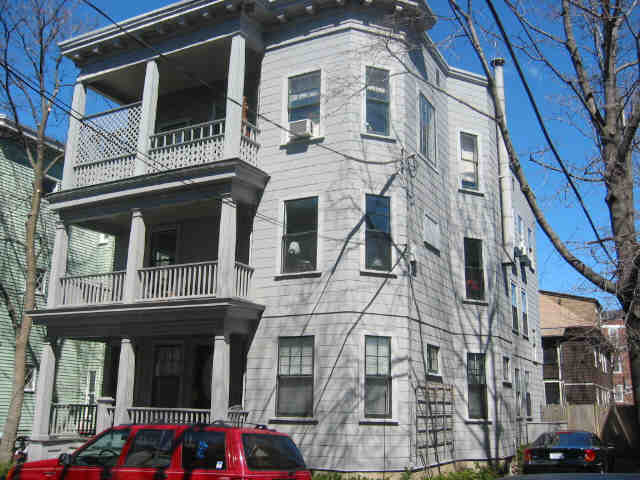A Look at the Massachusetts Condo Conversion Act of 1983
| . Posted in News - 3 Comments
By Kimberly Rau, MassLandlords, Inc.
Are you a landlord considering converting your apartments to condominiums? Maybe the eviction moratorium has stalled your business. Perhaps you’re just looking to get more money out of your rental property. Whatever the reason for considering “going condo,” a state law passed in 1983 by the Massachusetts Legislature may throw a few more hurdles in your path. Still, it may be worth your time, as business pundits are suggesting the condo market may be on the upswing.

Got a multi-family unit that you’re considering converting to condos? The process may be more involved than you think.
Image credit: cc-sa Brian Corr
When it comes to real estate, 2020 is undoubtedly a seller’s market for single-family homes. A combination of low-mortgage interest rates, low supply and lots of buyers means that single-family homes are getting snapped up within days of hitting the market. Locally, many Boston residents are leaving the city in favor of the suburbs, which will also affect Massachusetts’ house inventory. Boston Magazine suggests Covid-19 is playing a role.
“With no commutes to tie now-remote workers down, many urbanites have decided to pack up their home offices and move outwards—to Central Mass., the South Shore, the Cape, and other areas outside the perimeter of the city’s soaring price range. It may have started with a summer rental or few-month stint bunking up with family, but now that indefinite work-from-home policies and remote school plans are rolling in, many are making the move permanent,” the article states.
If you’re looking to get out of the landlord business, and selling your multi-unit building outright doesn’t appeal to you, you may be thinking about condo conversion. But before you put all your eggs in that basket, read on to see if it’s worth it to you.
What’s the difference between condos and apartments?
Condominiums and multi-unit apartments or other rental complexes may look similar on the outside, but they have some key differences. Apartments are often part of a set of multiple rental units, with the main building both owned and managed by a landlord and/or professional management company. Condominiums, or condos, are also part of multi-unit buildings (or complexes). However, each unit is designed to be owned outright by an individual. These owners may live in the units themselves, or rent them out. Management of condo rentals, just like with regular rental homes, may also be outsourced to a third-party company.
There are also co-ops, but this term is not interchangeable with “condominium.” Co-ops are owned and managed by their residents, who also own shares in a nonprofit corporation. The property is held in ownership by this nonprofit corporation, which also grants proprietary leases to residents of the co-op. For more differences, you can peruse this comprehensive article from the Washington Post that compares co-ops to condominiums.
Are there advantages to converting my rental units to condos?
The biggest thing that may entice landlords to convert their multi-unit building to condos is money. The owner-occupy housing market is hot right now. Landlords struggling to recover from months of owed rent under the recent eviction moratorium may be carefully examining their options.
“The advantage of converting a property into a condominium is that in most cases, you are greatly increasing the total re-sale value of the property,” states an article by Quincy law office Baker, Braverman & Barbadoro. Selling off one or more of your rental units in a seller’s market allows you to maximize property values. If your rental units are already in good repair, you might not even have to shell out that much cash to get them updated (and attractive to buyers).
On the other hand, if your units are on the dated side or cosmetically unattractive, updating your units may be costly.
“Establishing a top-tier condo means upgrading existing appliances and taking out old components,” states property investment site Mashvisor. “Consider the housing design trends in your area.” In other words, making a former apartment attractive to long-term buyers may take a bigger bite out of your budget than you were anticipating. And that’s before potential insurance hikes, application fees, and contractor fees.
And then, in Massachusetts, there’s the Condo Conversion Act.
The Condominium Conversion Act of 1983
In 1983, the Massachusetts Legislature enacted the Condo Conversion Law to help protect tenants in buildings of four or more rental units that were being converted to condominiums. The law allows communities to enact further restrictions that are greater or different from its stipulations.
This statute is Chapter 527 of Acts of 1983, and was incorporated into general law under MGL Ch. 183A.
Unless a municipality has other local ordinances or by-laws, there are four key points to the 1983 law that affect rental properties with four or more units. If you have two buildings adjacent to each other (with common ownership), the total number of these units will be added together to determine if your rental properties meet this threshold.
Rental tenants may not be immediately evicted
The first point is a big one: In developments with four or more rental units, you cannot just decide to convert your rental units to condos and file for eviction against your tenants. You must notify all of them, in writing, that you have filed a Master Deed and intend to terminate their tenancy. You can hand deliver this, or do it by certified or registered mail.
After you have notified your tenants, most of them will have one year to leave the rental property. Handicapped tenants, tenants over the age of 62, and low/moderate-income tenants have two years to leave. This can be extended for another two years if tenants in these categories cannot find a comparable rental in the same municipality.
Your tenants’ protection starts as soon as you announce intent to convert your rental units to condominiums. Preparing a Master Deed or Purchase and Sales Agreement count as “intent to convert,” so protections for renters begin early in the process.
You may still evict tenants for lease violations, including non-payment of rent (though the CDC eviction moratorium now in place might block certain evictions related to COVID-19).
You cannot increase the rent by an extreme amount
Thinking of raising the rent to get your tenants to voluntarily move? That’s a non-starter under Ch. 527. You may only raise the rent to match the Consumer Price Index (CPI), or by 10 percent, whichever is greater.
You must give your tenants right of first refusal
Your tenants currently occupying your soon-to-be-converted rental units have a 90-day grace period during which they have the option to purchase their unit. This must be done on the same (or better) terms that are offered to the general public.
Your tenants must receive a payout incentive
The law also puts in place a mandatory payment for all tenants who must relocate as a result of the condo conversion. This will cost you $750 per tenant, or $1,000 if the tenant is in one of the aforementioned protected groups (handicapped, elderly, low/moderate income). This rule applies to any tenant, as long as the tenant owes no rent and moves out before the conversion date on the notice.
Penalties for not following condominium conversion rules
As a landlord, ignoring any of these rules puts you in jeopardy. You can face fines of a minimum of $1,000 or a minimum of 60 days in jail for not complying.
Cities and towns may enact their own rules for condo conversion
As noted above, municipalities can enact stricter provisions on condominium conversions, either in place of or in addition to the state laws. It’s important that you know what your city or town requires before you start the conversion process.
For example, Boston gives its protected tenants up to five years to relocate if their rental unit is being converted to condominiums, but also states that this timeline can be extended with future legislation.
Somerville passed its condo conversion ordinance in July 2019. This replaced the one enacted in 1985. The city enacted these changes as it felt that “the terms of Somerville’s current ordinance do not reflect current market conditions.” The 2019 changes sought to provide more protections to tenants in vulnerable classes, and included tenants over the age of 62 and tenants with an income at or below 80% of the Area Median Income for 12 months immediately prior to the conversion notice. It also increased its notice period to five years for protected tenants. Landlords looking to convert a vacant building into condos must provide the Condo Review Board with a year’s notice and also give them a list of any tenants who resided in the property for the past 12 months, even if it is now vacant. It also upped the relocation benefit to $6,000 for most tenants, and $10,000 for elderly, disabled, or low/moderate-income tenants. This matches Boston’s current relocation benefit.
However, it’s worth noting that the Somerville legislation is currently in litigation. The Somerville Property Owners Coalition is suing the city, contesting the legality of the new ordinance as it is presently structured.
“The ordinance takes away your fundamental right to control your private property,” SPOC states on its site (linked above), and states that the ordinance’s restrictions devalue property and represent too much municipal control over private property.
Other cities or towns with more stringent condo conversion rules are Abington, Acton, Amherst, Brookline, Haverhill, Lexington, Malden, Marlborough, New Bedford and Newburyport. Make sure you are compliant with all local regulations.
Be careful with your condominium documents
When you convert your rental units to condominiums, there are two required documents: the master deed, and the declaration of trust. The master deed, which must be filed with the registry of deeds, denotes which parts of the building are considered privately owned condo units, and which parts are considered common areas. A master deed also includes a floor plan and lists the rights and responsibilities of the condo owners. You will also need to file individual deeds for each condo unit; this gives the condo owners the right to sell the condo if they desire.
The declaration of trust forms the condominium association and also outlines bylaws, rules and procedures that all condo owners must follow. These rules could include a cap on shared expenses. This is an important thing to spell out when you consider that multiple condo owners may have very different ideas about what’s reasonable when it comes to common area maintenance or utilities.
When these documents are created, it’s important to make sure they are well-written and comprehensive. Failure to do so can result in owners at odds with each other unnecessarily.
This is especially important when you are looking at small condo projects (four units or fewer). You’ll want your documents to reflect the consideration you’ve given to working with a small number of owners. Good documents will make prospective owners feel more comfortable about buying.
Jordana Roubicek Greenman, a Boston-based attorney who specializes in real estate and landlord/tenant issues, had a few suggestions to make condo projects, especially smaller ones, more equitable.
The first thing to remember is that condo ownership percentages may not always be evenly divided. For instance, if one of the condos is owned by the building owner, that condo may have a higher percentage of overall ownership than the other units (think a 65/35 split, or 50/25/25). In that case, Roubicek Greenman suggests that even in the event of uneven ownership percentages, condo documents drawn up afford everyone’s vote in community matters the same weight. In other words, just because you own a condo and a majority ownership, your vote counts the same as your other three tenants’ votes when it comes to a decision about how much to spend on snow removal.
She also suggests that condo document language for smaller projects (four or fewer units) mandate a unanimous vote to pass changes.
“It’s too easy for two to gang up on one,” Roubicek Greenman said.
No matter what your percentage split ends up being, Roubicek Greenman recommends that utilities be separate whenever possible. That means separate water meters, separate electrical meters, separate furnaces whenever possible. She recalled a case of a two-unit condo building in which the upstairs owner, a single individual, had a 65 percent ownership of the building. The condo documents required him to pay 65 percent of the utilities based on this percentage of ownership. This became a problem when a large family moved in downstairs. They only had to pay the remaining 35 percent of the water bill, but represented far more than 35 percent of the water usage. Separate utilities, or at least language in the condo documents that protects owners from disparities like the aforementioned example, can avoid disputes between neighbors.
“You never know who your neighbor is going to be,” she concluded, so working to avoid foreseeable issues before there’s a problem is best.
Conclusion
In conclusion, condo conversion may be right for you. But there are a lot of hoops to jump through before you can start reaping rewards from increased property values and sales. Consult with an accountant and attorney before diving in, and also talk to a realtor. Some areas just aren’t going to attract condo buyers, and that nice duplex in the middle of the suburbs may or may not be appropriate for development in this direction.




